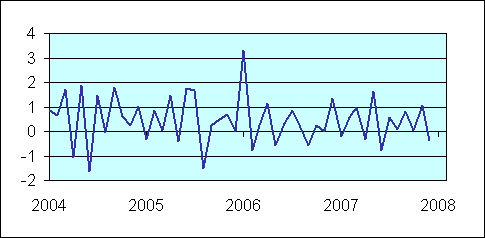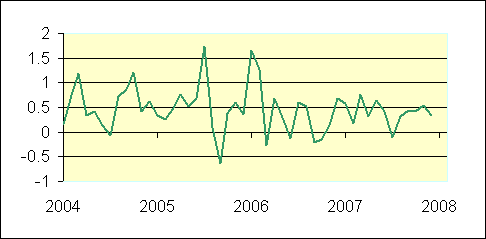Disappointing yes, but the financial press is getting a little carried away.
The Census Bureau reported today that seasonally adjusted nominal retail and food services sales fell 0.4% between November and December, which likely seems related to today’s 2.5% drop in the S&P500. MarketWatch had this reaction:
U.S. stocks plunged Tuesday, with the major indexes all closing at their lowest levels yet this year, after dismal December retail sales heightened anxieties about the economy and raised questions about the Federal Reserve’s ability to stem the damage.
Just how “dismal” is a 0.4% drop? A glance at recent data puts this in perspective. Even after data revisions, the numbers for retail sales are pretty noisy. Over the last few years, declines much bigger than that just reported for December are a fairly regular occurrence.
 |
The gain for the previous month (November over October) was last month reported to have been 1.2%, and has now been revised down to 1.0%. Still, a 1% monthly gain (12% at a noncompounded annual rate) is actually more remarkable than the 0.4% drop in December. If you’re willing to look at 2-month averages of the data, not much would seem to be amiss.
 |
To be sure, both the downward revision for November and the poor showing for December would cause us to revise the estimate of 2007:Q4 real consumption growth down from the 3.2% estimate we offered last month based on the October and November data alone. Still, the quarter’s growth of real consumption has to come out pretty respectable, despite the December numbers.
To the extent that people are alarmed, it is not because of the gravity of a single -0.4% monthly number for retail sales, but instead because today’s number is consistent with the impression from a number of other sources that the economy began to deteriorate in December.
For example, Calculated Risk also calls our attention today to this cheerful news from DataQuick:
A total of 13,240 new and resale houses and condos were sold in Los Angeles, Riverside, San Diego, Ventura, San Bernardino and Orange counties in December. That was up 0.5 percent from 13,173 for the previous month, and down 45.3 percent from 24,209 for December last year, according to DataQuick Information Systems.
Last month’s sales were by far the lowest for any December in DataQuick’s statistics, which go back to 1988. The sales count was 23.5 percent below the previous December low of 17,272 in 1990. The average December over the past 20 years is 25,543, the all-time peak for the month was reached in 2003 when 36,865 homes were sold.
Technorati Tags: macroeconomics,
housing,
economics,
retail sales,
recession
Totally agree with Marketwatch “getting carried away” and sighting just about any dang thing for why the market goes up or down.
Nonetheless, JDH, should we be looking at the monthly series, Oct-Dec (03 -> 07) to see if 0.4% drop is significant? I mean we can season our own stats right? (pulverizing them into submission with 2 month bites is not my favorite)
‘Even agree with this:
To the extent that people are alarmed, it is not because of the gravity of a single -0.4% monthly number for retail sales, but instead because today’s number is consistent with the impression from a number of other sources that the economy began to deteriorate in December
and for sure that would include the financial stocks led by Citi…not CR’s citation of DataQuick’s “cheerful news” so much that could be viewed as a housing bottom ( “up O.5%”) from the previous month…unless you were pulling a “Marketwatch” on us –we are payin attention, we are.
The press is paid to draw attention to itself, so hperventelating is not a surprise. What is important to the Fed and financial market participants is results vs expectations. It is somewhat interesting to know that real PCE growth may have been in the normal range in Q4. It is far more interesting, from the point of view of figuring out what to do, to learn that demand in Q4 was considerably weaker than expected. Let’s not miss the fact that October sales were revised lower as well. That 0.2% downward revision to November was in terms of change. The level for November was about 0.4% lower than we thought because the level for October was about 0.2% lower than we thought. The level for December was about 0.8% lower than we thought, because of the lower base. Growth in retail sales was over 1% lower for all of Q4 than was expected prior to the release of December’s reoprt.
However December is the highest volume month for many retailers. So a decline of 0.4% + their rapidly inflating expenses would equal nasty conditions depending on their industry.